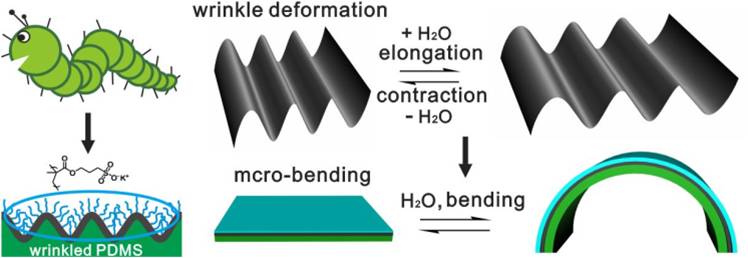Research Progress
Caterpillar Actuator
发布时间: 2015-05-26 05:53 点击:3029
Natural plants and muscular organs have the ability to convert physical or chemical signals into macroscopic movements, for example, the caterpillar moves forward step-by-step through the expansion/contraction of the body.

Prof. Zhou et al., from Lanzhou Institute of Chemical Physics, Chinese Academy of Sciences reported a caterpillar-mimetic bilayer actuator, based on a wrinkled PDMS elastomer decorated with a hydro-responsive polyelectrolyte brush. The actuator can fold ultra-fast into complex three-dimensional structures upon a change in relative humidity of the surrounding air. The folding direction is determined by the geometry of the actuator, the orientation of the wrinkles and the gradient in polymer height on the surface. And some unique structures such as helicoid and gradient can be obtained. The adaptive bending movement is very fast, anisotropic, highly efficient and reversible. When the environmental humidity is repeatedly cycled up and down, the small device walks on a surface with a roughness gradient, which is reminiscent the caterpillar-like movements. (provided by Professor Feng Zhou from Lanzhou Institute of Chemical Physics, Chinese Academy of Sciences, China)
Address: C508 Dingxin Building, Jilin University, 2699 Qianjin Street, Changchun 130012, P. R. China
Copyright © 2024 International Society of Bionic Engineering All Rights Reserved
吉ICP备11002416号-1
Copyright © 2024 International Society of Bionic Engineering All Rights Reserved
吉ICP备11002416号-1









